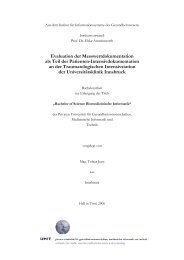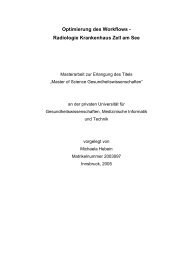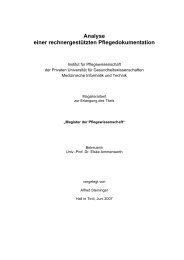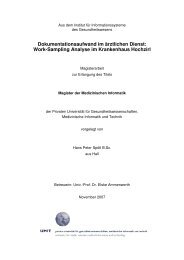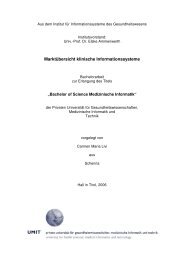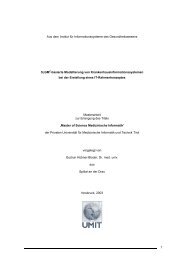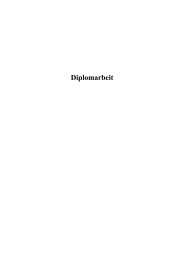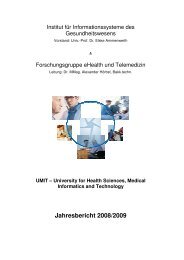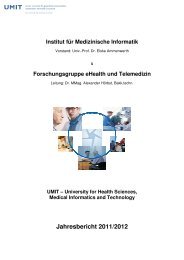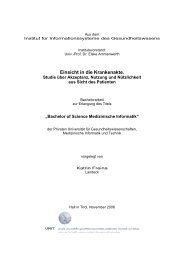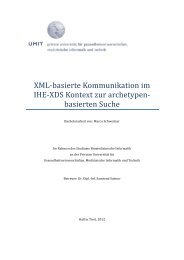bewertung für ein Konzept zur papierlosen Archivierung am ... - UMIT
bewertung für ein Konzept zur papierlosen Archivierung am ... - UMIT
bewertung für ein Konzept zur papierlosen Archivierung am ... - UMIT
Sie wollen auch ein ePaper? Erhöhen Sie die Reichweite Ihrer Titel.
YUMPU macht aus Druck-PDFs automatisch weboptimierte ePaper, die Google liebt.
Abstract<br />
The use of highly developed information and communication technology in Medicine<br />
brings about a steady rise of data about a patient, which has to be collected and<br />
made accessible. According to the law, these documented data are to be kept on file<br />
up to thirty years, leading to space problems in the archives of the state hospital<br />
Hall. Such problems could be solved by introducing an electronic medical record<br />
(EMR). In order to obtain a comprehensive EMR, all remaining paper-based files<br />
need to be digitalized by scanning.<br />
This paper aims at ex<strong>am</strong>ining and assessing the subinformation system “Archive of<br />
patient files“ in a systems analysis to draw up a concept for archiving paperless by<br />
substitutional scanning of the paper files for the state hospital Hall.<br />
Queries in the database of the digital archiving system are performed in a quantita-<br />
tive secondary data analysis. After that, a quantitative primary data analysis will be<br />
conducted, in which 802 documents of 51 files of overall six specialist departments<br />
are gathered. The file documents are classified as electronic, scanned, paper-based,<br />
printed or substitutionally scanned and matched to the appropriate document type.<br />
The archiving processes of selected departments are ex<strong>am</strong>ined and outlined in a<br />
qualitative analysis by observing and interviewing. The assessment and the concept<br />
for paperless archiving are based on this systems analysis.<br />
The results of the file analysis show that 36% of the documents in the remaining files<br />
are redundant, i.e. they have been printed or scanned. On average, one file contains<br />
7.2 paper-based documents, which have not been printed or scanned and will have<br />
to be scanned in the future. The results of the qualitative analysis show that the<br />
departments archive individually, thus revealing many weaknesses of the different<br />
archiving systems. The concept for paperless archiving includes the centralized di-<br />
gitalizing of the remaining paper-based files (about 23,000 files per year) after the<br />
patient’s discharge by mass scanning and the subsequent destruction of the scan-<br />
ned files. The concept designates two permanent posts and two high performance<br />
scanners. The scanned files will be available in the EMR.<br />
In the course of implementing these plans, changes of the accustomed work routine<br />
are expected, making it necessary to include the employees into the project “pa-<br />
perless archiving“. The medium-term goal is to reduce the <strong>am</strong>ount of paper, used<br />
for originally electronic documents (e.g. electronic temperature curve), in order to<br />
enable the employees a work environment without much media disruption.





